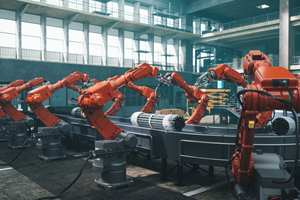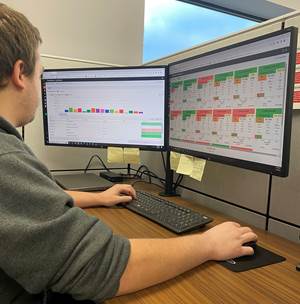Making Profilers More Productive
The trend in aircraft design is larger monolithic aluminum components that are lighter and stiffer than counterparts that are assembled from smaller pieces. Problem is, the larger, more complex parts necessitate significantly longer machining times on conventional horizontal-table profiling machines, underscoring the need for faster, more powerful profiling machines capable of machining a mix of such components quickly and efficiently.
Share




The trend in aircraft design is larger monolithic aluminum components that are lighter and stiffer than counterparts that are assembled from smaller pieces. Problem is, the larger, more complex parts necessitate significantly longer machining times on conventional horizontal-table profiling machines, underscoring the need for faster, more powerful profiling machines capable of machining a mix of such components quickly and efficiently.
Ingersoll Milling Machine Co. recently introduced a second-generation, high speed profiling machine for the aircraft industry that incorporates at least two features that improve productivity to the point that they will probably become standard in all such future machines. Called the High Velocity Profiler (HVP), the machine is capable of simultaneous five-axis machining of parts at spindle speeds up to 20,000 rpm.
The machine is not only fast, but it is also capable of taking hefty cuts. It can achieve metal removal rates up to 6,440 cm3/min., partly due to a 75 kW (100 hp), 20,000-rpm, fluid bearing spindle Ingersoll designed especially for the HVP. The fluid bearing spindle runs on an externally pressurized fluid (oil) film. Unlike conventional mechanical ball bearings, it does not wear under normal operating conditions, resulting in long bearing life. Also, since the fluid bearing is externally pressurized, the spindle can run over the entire speed range (0 to 100 percent) without loss of bearing stiffness. The dynamic stiffness of the fluid bearing spindle is 5-6 times greater than that of mechanical bearing spindles, which makes possible significantly higher metal removal rates.
Fluid bearing spindles are free of the vibration created by conventional ball bearing spindles. As a result, tools last longer. Fluid bearing spindles also have better concentricity. Tools run truer, which permits a more uniform distribution of the load on the tool's cutting edges. Finally, fluid bearing spindles reduce or eliminate chatter that can cause premature tool failure through micro-chipping of the sharp cutting edges.
It does not make a lot of sense to have a high speed spindle if the machine stands idle for long periods while machined spars, wing panels, and so forth are manually unloaded and replaced with fresh billets or plate sections. Thus, the automated load-unload features designed for the HVP multiply the value of the machine's productivity in the cut.
To begin with, the aluminum plate sections are machined standing on edge. They are secured on pallets that carry them in and out of the profiler's machining area. The profiler includes horizontal and vertical pallet handling components that accommodate totally automated material handling and, just as important, expedite loading and unloading to minimize machine idle time. Pallet-handling components shown in the drawing include a two-position (vertical) pallet transporter and a setup platform at right for loading pallets in a horizontal position.
According to Ingersoll, the HVP delivers productivity increases ranging from 4:1 to 11:1 over conventional gantry-type, vertical spindle profilers. Spars that require 50 hours of machining on the conventional machines can now be done in slightly more than 5 hours on the HVP. In a demonstration involving the machining of an aircraft wing section from a 109 by 23 ½ by 3-inch billet of 7475-T7351 aluminum alloy (tough to machine), the rough and finish machining (performed at 18,000 rpm and 16,500 rpm respectively) totaled about 70 minutes. That compares to 10 hours of machining time that was used to produce the part on a conventional profiling machine. Ingersoll points out that the HVP, with its higher cutting rate and automated load-unload capability, can perform the work of several older horizontal-table profilers, with corresponding savings in labor and plant space.
The HVP is also available with a 40,000 rpm, 80-kW, fluid bearing spindle and automatic spindle changing. The in-line fluid bearing spindle can be used for five-axis contouring cuts and can be replaced automatically by a right-angle head for five-sided machining.
Related Content
Solar Atmosphere Receives Boeing Approval for Vacuum Oil Quenching
The approval was granted for oil quenching of alloy steels in the company’s new furnace, the Neo.
Read MoreIncreasing OEM Visibility to Shopfloor Operations for the Win
A former employee of General Motors and Tesla talks about the issues that led to shutdowns on factory lines, and what small- to medium-sized manufacturers can do today to win business from large OEMs.
Read MoreBavius Technologie Appoints New President, Schedules Technology Showcase
Roy D. Cripps will lead the team at Bavius as it aims to expand its current business in aerospace structures and develop new market segments. Additionally, the company will showcase its technology during an open house event on June 11.
Read MoreMachine Monitoring Boosts Aerospace Manufacturer's Utilization
Once it had a bird’s eye view of various data points across its shops, this aerospace manufacturer raised its utilization by 27% in nine months.
Read MoreRead Next
Registration Now Open for the Precision Machining Technology Show (PMTS) 2025
The precision machining industry’s premier event returns to Cleveland, OH, April 1-3.
Read More5 Rules of Thumb for Buying CNC Machine Tools
Use these tips to carefully plan your machine tool purchases and to avoid regretting your decision later.
Read MoreSetting Up the Building Blocks for a Digital Factory
Woodward Inc. spent over a year developing an API to connect machines to its digital factory. Caron Engineering’s MiConnect has cut most of this process while also granting the shop greater access to machine information.
Read More

















.png;maxWidth=300;quality=90)


















